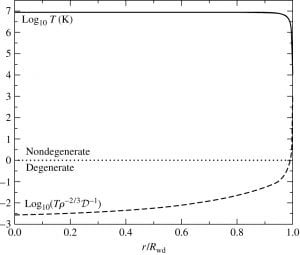Motivation and Background
White dwarfs are some of the oldest observable objects in the universe. Their age and relative stability provide a window in the history of our galaxy and our universe as a whole. White dwarfs are the remnants of the least massive stars, and therefore the most common fate of stars. Therefore a better understanding of the life cycle of these stellar remnants can be used to unlock the abundance of information on the earlier universe hidden in white dwarfs. To that end I present a basic overview of the cooling of white dwarfs below
Condition for Degeneracy
White dwarfs, like the cores of the stars that came before them, are supported by degeneracy pressure. However the entirety of a white dwarf is not degenerate. Every white dwarf has a very narrow band at the edge of it where gas pressure predominates, called the atmosphere. This thin layer plays a central role in white dwarf cooling, determining how much energy can leave the dense, hot core of the white dwarf as light. To find a condition on degeneracy we compare the kinetic energies and the Fermi energies to arrive at a condition on temperature and density
For a typical white dwarf and the right side can be evaluated to give a condition on degeneracy. We’ll call this computed value
for brevity’s sake.
Caroll & Ostlie
Using this condition we can evaluate where degeneracy and where gas pressure predominate in a model white dwarf, as plotted above.
An Approximation for White Dwarf Atmospheres
Combining some stellar atmosphere approximations and the ideal gas law we can arrive at the formula:
where is the bound-free opacity. This provides a relationship between luminosity, temperature, and density in a white dwarf atmosphere. But! we already have a condition on temperature and density in a white dwarf atmosphere. The degeneracy condition. As an approximation we can convert this condition to an equality and arrive at a formula for white dwarf Luminosity:
You’ll notice that the in the last equation has become
here. This is because the degenerate cores of white dwarfs are nearly isothermal due to the efficiency of electron conduction. As such the temperature at the bottom of the atmosphere is very nearly the central temperature of the white dwarf. We can further paramaterize this complicated formula and arrive at:
where
An Example White Dwarf
Using this previous formula and values of and
, we arrive at a white dwarf luminosity of
. Further, we can use this luminosity and the thermal energy within the white dwarf to produce a characteristic timescale.
To find the thermal energy:
where A = 12 for carbon, gives for our example a value of . Now for the cooling timescale of this white dwarf.
This timescale is deceptively fast, as the white dwarf cools its luminosity will also drop off.
The Cooling Curve and its Implications
The luminosity is the loss of energy for a white dwarf:
And integrating with the proper bounds we arrive at:
The cooling of white dwarfs closely follows a simple power law! Combined with observations, astroseismology, and the initial mass function, it’s possible to approximate when star formation started. For the outer disk of the Milky Way a value of was obtained by winget et all in 1987.
References
B.W. Carroll and D.A. Ostlie, An Introduction to Modern Astrophysics (Cambridge University Press, Cambridge, 2018).
Winget et all.,Ap. J. Lett., 315, L77, 1987.

Great article. Thank you for sharing this wonderful post. you give me some insight. Regards